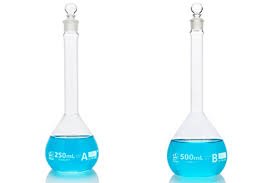Calibration of Glassware (Class A and Class B)

Calibration of Glassware – Class A vs Class B
Class A
-
Higher accuracy and tighter tolerance limits.
-
Calibrated to meet ISO, USP, or ASTM standards.
-
Used in critical pharmaceutical and analytical work where precision is crucial.
-
Example tolerance for 100 mL volumetric flask: ±0.10 mL.
Class B
-
Lower accuracy with approximately double the tolerance limits of Class A.
-
Used in general laboratory work where ultra-high accuracy is not required.
-
Example tolerance for 100 mL volumetric flask: ±0.20 mL.
Calibration Principle:
-
Based on gravimetric method using distilled water and a calibrated analytical balance.
-
Actual volume is calculated from water weight and density, compared against nominal capacity.
Key Difference in Calibration Approach:
-
Same procedure for both classes, but acceptance criteria differ as per tolerance limits.
-
Class A must meet tighter specifications; Class B allows larger deviations.

